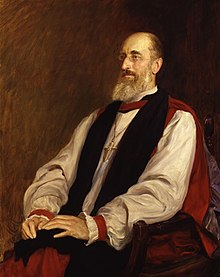Mandell Creighton | |
|---|---|
| Bishop of London | |
 Creighton as Bishop of London, by Hubert von Herkomer. | |
| Church | Church of England |
| Diocese | Diocese of London |
| Installed | January 1897 |
| Term ended | 1901 (death) |
| Predecessor | Frederick Temple |
| Successor | Arthur Winnington-Ingram |
| Other post(s) |
|
| Orders | |
| Ordination | 1893 |
| Consecration | 1891 |
| Personal details | |
| Born | 5 July 1843 |
| Died | 14 January 1901 (aged 57) |
| Buried | St Paul's Cathedral, London |
| Denomination | Anglican |
| Spouse | Louise von Glehn (m. 1872) |
| Children | 7 children |
| Alma mater | Merton College, Oxford |
Mandell Creighton (/ˈmændəl ˈkraɪtən/; 5 July 1843 – 14 January 1901) was a British historian, Anglican priest and bishop. The son of a stern but successful carpenter, Creighton studied at University of Oxford, focusing his scholarship on the Renaissance Papacy. He was appointed the first occupant of the Dixie Chair of Ecclesiastical History at the University of Cambridge in 1884. The following year, he also was engaged as the first editor of the English Historical Review, the oldest English language academic journal in its field. In these posts, he helped to establish history as an independent academic discipline in England.
Creighton had a parallel career in the clergy of the Church of England from the mid-1870s until his death. He served as a parish priest in Embleton, Northumberland and later, successively, as a Canon Residentiary of Worcester Cathedral (1885), Bishop of Peterborough (1891) and Bishop of London (1897). His moderation and practicality drew praise from Queen Victoria and won notice from politicians. In later years, he was appointed to various positions of trust, including the Privy Council, and it was widely thought that he would have become Archbishop of Canterbury had his death, at the age of 57, not supervened.
Creighton's historical work received mixed reviews. He was praised for scrupulous even-handedness, but criticised for not taking a stand against historical excesses. He was firm in asserting that public figures be judged for their public acts, not private ones. His preference for the concrete to the abstract is seen in his writings about the Church of England. He believed that the Church was uniquely shaped by its particular English circumstances, and he saw it as the soul of the nation.
Creighton was married to the author and future women's suffrage activist Louise Creighton, and the couple had seven children. A man of complex intelligence and exceptional vigour, Creighton was emblematic of the Victorian era both in his strengths and in his failings.